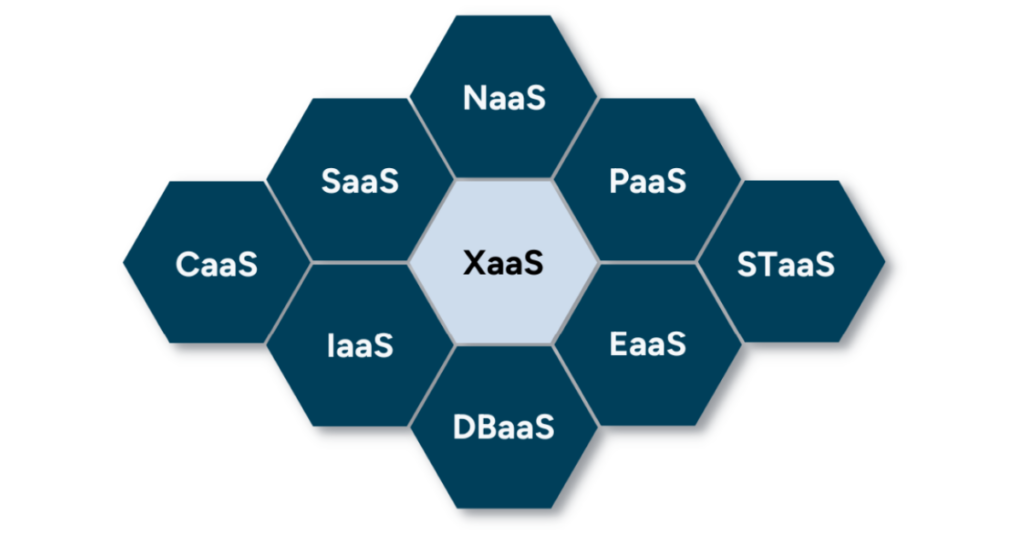
Everything-as-a-Service (XaaS) is a business model where companies offer products and services over the Internet as a recurring service, allowing businesses to provide customers with access to products and services on demand.
“Everything-as-a-Service” (XaaS) refers to the delivery and consumption of various hardware, infrastructure, and software products, services, and solutions. Generally XaaS follows a recurring business model which includes pay-as-you-go (or pay-per-use), tiered pricing subscriptions, or hybrid models. The concept derives from the idea that any IT functionality can be provided as a recurring service. This has revolutionized the way businesses use technology by reducing maintenance and management costs while increasing flexibility and accessibility. It is popular due to its “win/win” reputation of providing customers with increased value for the cost and increased reliability of revenues.
General Information on XaaS
The term XaaS can be understood to encompass any activity previously carried out locally via physical infrastructure, now offered through a cloud service provider. The most critical technological advancement enabling XaaS is cloud computing. As cloud computing has become mainstream, organizations have adopted different service models. These include Infrastructure-as-a-Service (IaaS), Software-as-a-Service (SaaS), and Platform-as-a-Service (PaaS). XaaS includes all these services as well as others like Desktop-as-a-Service (DaaS), Storage-as-a-Service (STaaS), Container-as-a-Service (CaaS), and many more.
How XaaS Works
XaaS models offer products and services on a recurring basis, often as a pay-per-use (often called pay-as-you-go). Therefore, businesses can often access them without initial investments or one-time licensing fees. Vendors that adopt XaaS focus on customer retention, driving adoption, growth, and renewals. The model is particularly popular in IoT and industrial IoT domains, where equipment (that is often still bought outright) or products can be offered as part of an extended service, including maintenance and repair. This enables organizations to shift from capital expenditure (Capex) to operational expenditure (Opex) models, optimizing their resources and finances. They can do this because the responsibility of the product lifecycle has shifted from the customer to the vendor.
General "how-to's" to implement an XaaS model
1. Identify which products or services to offer through this model: This may involve adapting existing products or creating new ones to fit the XaaS format. The business should also determine the pricing and billing structure for the service and establish a secure and reliable system for delivering the service over the internet.
2. Develop a marketing strategy to promote XaaS offerings: For example, by creating a website or landing page, developing targeted advertising campaigns, and leveraging social media and other online channels. Businesses should also consider providing customer support and training. Doing so will ensure that users are able to effectively use the service.
3. Implement the right billing and monetization software: This software enables businesses to efficiently manage and automate the recurring billing process, collect payments, and track revenue and customer information. Without it, businesses risk facing billing and payment errors, lost revenue, and dissatisfied customers, which can negatively impact the success of their XaaS offering.
4. Continually evaluate and refine XaaS offerings: Businesses might have to update their service to include new features, improve its performance, or make other changes based on customer feedback. By continually improving its XaaS offerings, a business can stay ahead of its competition and remain relevant in an increasingly competitive marketplace.
Difference between XaaS and Servitization
There is a difference between “everything-as-a-service” (XaaS) and servitization, although they both relate to the concept of delivering services in various industries.
Servitization is a business strategy that involves shifting from a traditional product-centric model to one focused on providing services or solutions that enhance the value for customers. This transformation goes beyond just selling physical products and includes offering a range of services such as maintenance, support, upgrades, and other value-added offerings alongside the core product. Servitization is typically associated with the manufacturing industry, where companies aim to build long-term customer relationships by offering services that improve the customer’s experience and reduce the total cost of ownership. It often involves a shift in mindset from a one-time product sale to ongoing customer engagement and recurring revenue streams.
In summary, XaaS is a broader, technology-oriented concept that involves delivering various services via digital platforms, while servitization is a strategic approach to transform traditional product-oriented businesses into service-centric ones, primarily seen in the manufacturing industry. XaaS can be one of the tools used in the process of servitization to deliver services more efficiently and effectively.
Looking for a billing and monetization software that can accommodate XaaS business models with ease? Look no further. Get in touch to find out how Nitrobox can help.
30 days. 0 costs. Full access.
Get a Nitrobox free trial, for 30 days, no credit card needed. Complimentary consultation discussing your unique pain-points included.